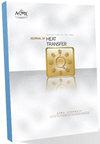Investigation of Thermal-Flow Behavior and Droplet Dynamics of Mist Sweeping Impinging Jet Cooling
IF 2.8
4区 工程技术
Q2 ENGINEERING, MECHANICAL
引用次数: 0
Abstract
This paper presents a 2-D numerical study to investigate the fluid flow behavior and cooling characteristics caused by injecting tiny droplets into the sweeping air jet through a fluidic oscillator. An unsteady Reynolds-averaged Navier-Stokes simulation accompanied with the k-ω SST turbulence model is used in this study. The movement and evaporation of the mist are simulated by using the discrete phase model. The study has been conducted for a target wall with a constant heat flux of 3,000 W/m2, jet-to-wall distance of 4, ReD=2,500, and a mist /air mass ratio of 5% with a droplet size of 5 microns. A comparison between the cooling performance of steady and sweeping jets is presented for two impingement schemes. The approach of using a slip upper wall boundary condition as an alternative of the unconfined impingement scheme is investigated as well. The results show that adding mist provided a temperature reduction of 5-10% on the target wall in all cases when compared to the air cases. The liquid droplet coalescence phenomenon prevails in the sweeping jet case. For the confined impingement, both mist jets provided the similar average temperature reduction. However, the steady mist jet introduced a 58% more target wall shear compared to the sweeping mist jet. For the unconfined impingement, the steady mist jet achieved a better average cooling performance compared to that of the sweeping mist jet. However, the steady mist jet introduced a 72% more target wall shear.扫雾冲击射流冷却的热流行为和液滴动力学研究
本文采用二维数值方法研究了通过射流振荡器向扫气射流中注入微小液滴所引起的流体流动特性和冷却特性。本文采用非定常reynolds -average Navier-Stokes模拟和k-ω海温湍流模型。采用离散相模型对雾的运动和蒸发过程进行了模拟。研究的目标壁面热流密度为3000 W/m2,射流与壁面距离为4,ReD= 2500,雾/空气质量比为5%,液滴尺寸为5微米。比较了两种冲击方案下定常射流和扫掠射流的冷却性能。研究了采用滑移上壁边界条件替代无侧限碰撞方案的方法。结果表明,在所有情况下,与空气情况相比,添加薄雾可使目标壁面温度降低5-10%。在扫射工况中,液滴聚并现象普遍存在。对于受限撞击,两种雾射流的平均降温效果相似。然而,与扫雾射流相比,稳定雾射流引入的靶壁剪切量增加了58%。对于无侧限冲击,稳定雾射流的平均冷却性能优于扫雾射流。然而,稳定雾射流引入了72%以上的目标壁剪切。
本文章由计算机程序翻译,如有差异,请以英文原文为准。
求助全文
约1分钟内获得全文
求助全文
来源期刊
自引率
0.00%
发文量
182
审稿时长
4.7 months
期刊介绍:
Topical areas including, but not limited to: Biological heat and mass transfer; Combustion and reactive flows; Conduction; Electronic and photonic cooling; Evaporation, boiling, and condensation; Experimental techniques; Forced convection; Heat exchanger fundamentals; Heat transfer enhancement; Combined heat and mass transfer; Heat transfer in manufacturing; Jets, wakes, and impingement cooling; Melting and solidification; Microscale and nanoscale heat and mass transfer; Natural and mixed convection; Porous media; Radiative heat transfer; Thermal systems; Two-phase flow and heat transfer. Such topical areas may be seen in: Aerospace; The environment; Gas turbines; Biotechnology; Electronic and photonic processes and equipment; Energy systems, Fire and combustion, heat pipes, manufacturing and materials processing, low temperature and arctic region heat transfer; Refrigeration and air conditioning; Homeland security systems; Multi-phase processes; Microscale and nanoscale devices and processes.

 求助内容:
求助内容: 应助结果提醒方式:
应助结果提醒方式:


